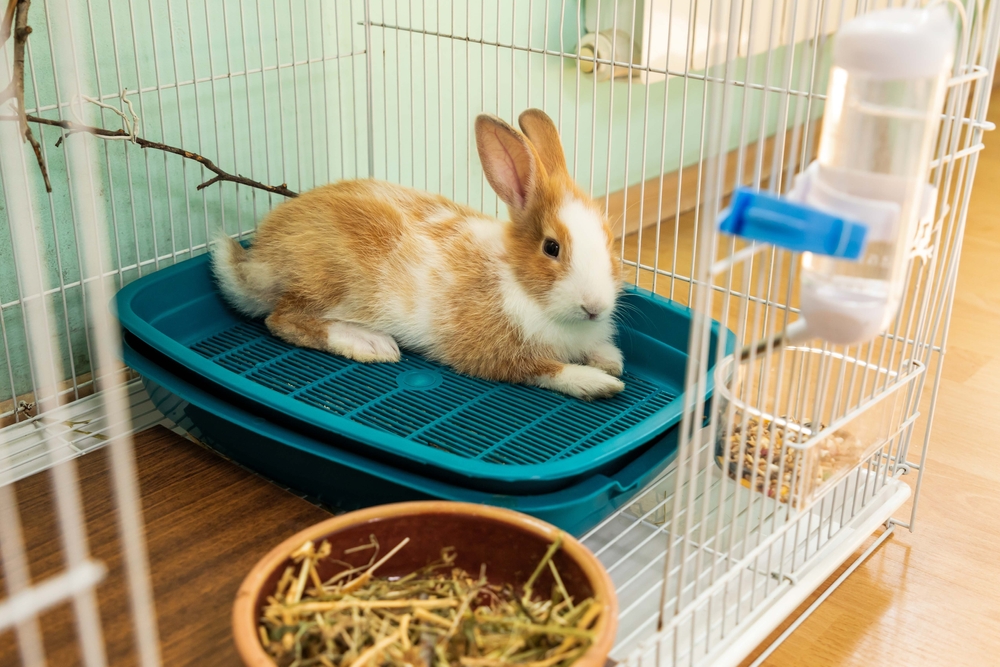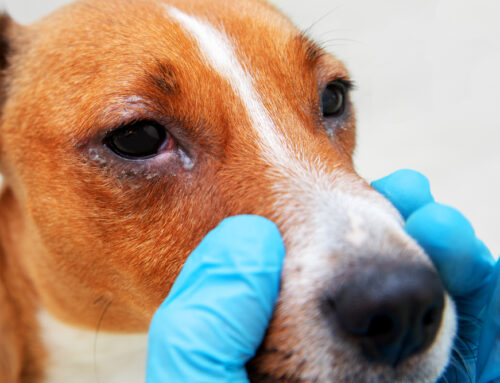Encephalitozoonosis is a protozoan parasitic infection caused by Encephalitozoon cuniculi that can damage your rabbit’s kidneys, nervous system, heart, and eyes. In addition, the disease is zoonotic, which means your pet rabbit can pass the infection to you and your family. Our team at Veterinary Vision Center wants to provide information about this concerning condition, and explain steps to protect your pet and your family.
How is E. cuniculi transmitted in pet rabbits?
cuniculi has two transmission methods:
- Urine — Protozoal spores are shed in affected animals’ urine, contaminating the environment. They can stay infective for months in cool, humid environments, and have been known to live for at least a month at room temperature. If your rabbit ingests or inhales these spores, they will become infected.
- In utero — Infected does can pass the infection to their unborn kittens.
Infected rabbits can also transmit the disease to humans. Children, the elderly, and immunocompromised people are most at risk.
What are E. cuniculi signs in pet rabbits?
Most healthy rabbits successfully fight E. cuniculi and never show signs, but if the disease overcomes their immune system, several body systems can be affected.
- Eyes — Spores that infect the rabbit’s eyes cause inflammation inside the eye (i.e., uveitis), which can cause the rabbit’s eye to tear. This inflammation can lead to cataract formation, making the rabbit’s eye appear cloudy, and the cataracts can mature to a stage that causes blindness.
- Kidney — When the spores damage the rabbit’s kidneys, signs include lethargy, poor appetite, weight loss, and increased thirst and urination.
- Nervous system — When the spores affect the brain and nerves throughout the rabbit’s body, signs include a head tilt, difficulty chewing food, weakness in the hind limbs, urine dribbling, paralysis, and seizures.
- Heart — When the spores damage the rabbit’s heart, signs include rapid breathing, reluctance to exercise, and increased time sleeping.
How is E. cuniculi diagnosed in pet rabbits?
Your veterinarian may suspect encephalitozoonosis based on clinical signs. However, E. cuniculi can be difficult to definitively diagnose, because other conditions can cause similar problems, and many infected rabbits don’t shed the spores continuously. In addition, E. cuniculi diagnostic testing can be expensive. Diagnostic tests for the parasite include:
- Polymerase chain reaction (PCR) test — A swab of an infected rabbit’s urine may find E. cuniculi deoxyribonucleic acid (DNA), if the rabbit is shedding spores when their urine is tested.
- Enzyme linked immunosorbent assay (ELISA) test — This test can detect antibodies to E. cuniculi in a blood sample, indicating the rabbit’s exposure to the parasite.
- Protein electrophoresis — This test assesses the protein types in the rabbit’s blood, differentiating between active disease and a past illness.
- Advanced imaging — A computed tomography scan or magnetic resonance imaging may detect brain lesions caused by E. cuniculi. While these tests can’t determine if the lesions are caused by the parasite, they can reveal the location and size of the lesions, which can help determine if the rabbit will likely improve or have permanent neurological abnormalities.
How is E. cuniculi treated in pet rabbits?
Treatment for encephalitozoonosis mainly involves supportive care, since no effective treatments are currently available. Other treatments that your veterinarian may prescribe include:
- Antiparasitic drugs — Certain wide-spectrum antiparasitic drugs are commonly prescribed to treat E. cuniculi.
- Steroids — Steroids may be prescribed to help reduce the inflammation caused by the parasites, but these drugs can also suppress the rabbit’s immune system and cause further problems.
- Nonsteroidal anti-inflammatories — These medications may more safely reduce inflammation.
- Antibiotics — Certain antibiotics known to have anti-inflammatory properties may be prescribed.
How are cataracts treated in pet rabbits?
If the rabbit has cataracts but is otherwise healthy, surgery can be performed to remove the cataracts, to prevent blindness. A procedure called phacoemulsification, using a special tool that emits ultrasonic vibrations, is performed to liquefy the lens. The lens is then suctioned from the eye. In other species, the removed lens is replaced with an artificial lens, but these lenses are not available in acceptable sizes for rabbits, so the rabbit’s vision will be slightly blurry after the surgery. Most rabbits adapt quickly, and have no problems with this issue. After surgery, rabbits are typically sent home with several different eye drops that must be administered several times a day for a week, and they usually need to stay on at least one eye drop for several weeks to months after surgery.
How is E. cuniculi prevented in pet rabbits?

Encephalitozoonosis can’t be prevented in all cases, but you can take steps to safeguard yourself and your rabbit, including:
- Daily cleaning — Every day remove all obvious urine, feces, and organic dirt from your rabbit’s environment.
- Weekly cleaning — Disinfect your rabbit’s cage, food bowls, and other furnishings at least once a week.
- Wash your hands — Always wash your hands thoroughly after handling your rabbit.
E. cuniculi is a dangerous parasite that can have significant repercussions if your rabbit is infected, but taking certain precautions can decrease your rabbit’s risk. If encephalitozoonosis has caused your rabbit to develop cataracts, contact our team at Veterinary Vision Center, so we can preserve their vision.







Leave A Comment